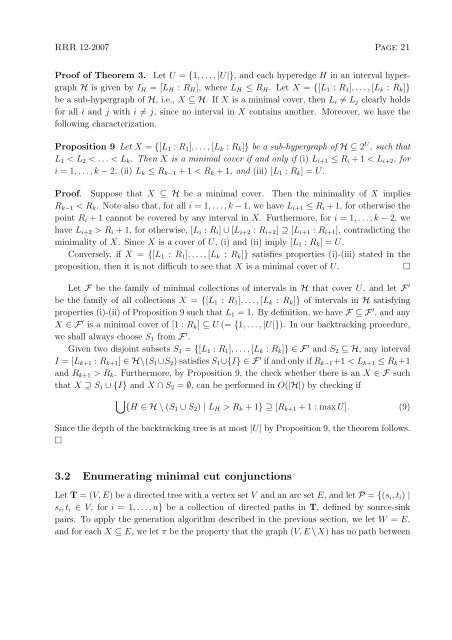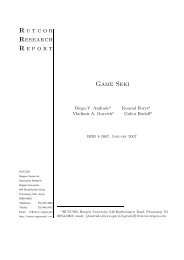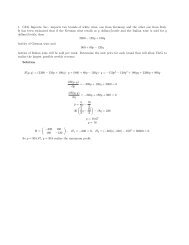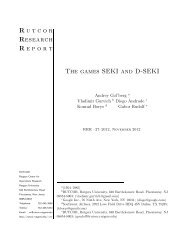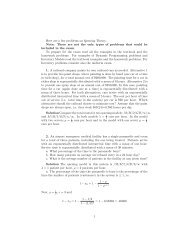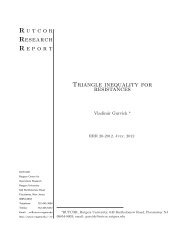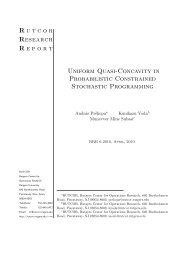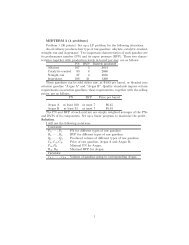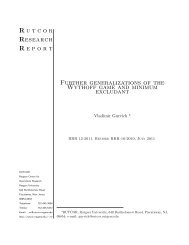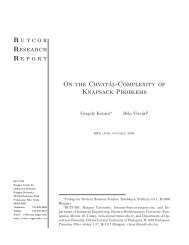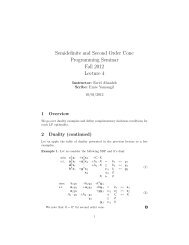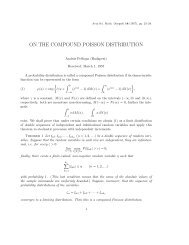RRR 12-2007 Page 21Pro<strong>of</strong> <strong>of</strong> Theorem 3. Let U = {1,...,|U|}, <strong>and</strong> each hyperedge H in an interval hypergraphH is given by I H = [L H : R H ], where L H ≤ R H . Let X = {[L 1 : R 1 ],...,[L k : R k ]}be a sub-hypergraph <strong>of</strong> H, i.e., X ⊆ H. If X is a minimal cover, then L i ≠ L j clearly holdsfor all i <strong>and</strong> j with i ≠ j, since no interval in X contains another. Moreover, we have thefollowing characterization.Proposition 9 Let X = {[L 1 : R 1 ],...,[L k : R k ]} be a sub-hypergraph <strong>of</strong> H ⊆ 2 U , such thatL 1 < L 2 < ... < L k . Then X is a minimal cover if <strong>and</strong> only if (i) L i+1 ≤ R i + 1 < L i+2 , fori = 1,...,k − 2, (ii) L k ≤ R k−1 + 1 < R k + 1, <strong>and</strong> (iii) [L 1 : R k ] = U.Pro<strong>of</strong>. Suppose that X ⊆ H be a minimal cover. Then the minimality <strong>of</strong> X impliesR k−1 < R k . Note also that, for all i = 1,...,k − 1, we have L i+1 ≤ R i + 1, for otherwise thepoint R i + 1 cannot be covered by any interval in X. Furthermore, for i = 1,...,k − 2, wehave L i+2 > R i + 1, for otherwise, [L i : R i ] ∪ [L i+2 : R i+2 ] ⊇ [L i+1 : R i+1 ], contradicting theminimality <strong>of</strong> X. Since X is a cover <strong>of</strong> U, (i) <strong>and</strong> (ii) imply [L 1 : R k ] = U.Conversely, if X = {[L 1 : R 1 ],...,[L k : R k ]} satisfies properties (i)-(iii) stated in theproposition, then it is not difficult to see that X is a minimal cover <strong>of</strong> U.□Let F be the family <strong>of</strong> minimal collections <strong>of</strong> intervals in H that cover U, <strong>and</strong> let F ′be the family <strong>of</strong> all collections X = {[L 1 : R 1 ],...,[L k : R k ]} <strong>of</strong> intervals in H satisfyingproperties (i)-(ii) <strong>of</strong> Proposition 9 such that L 1 = 1. By definition, we have F ⊆ F ′ , <strong>and</strong> anyX ∈ F ′ is a minimal cover <strong>of</strong> [1 : R k ] ⊆ U (= {1,...,|U|}). In our backtracking procedure,we shall always choose S 1 from F ′ .Given two disjoint subsets S 1 = {[L 1 : R 1 ],...,[L k : R k ]} ∈ F ′ <strong>and</strong> S 2 ⊆ H, any intervalI = [L k+1 : R k+1 ] ∈ H\(S 1 ∪S 2 ) satisfies S 1 ∪{I} ∈ F ′ if <strong>and</strong> only if R k−1 +1 < L k+1 ≤ R k +1<strong>and</strong> R k+1 > R k . Furthermore, by Proposition 9, the check whether there is an X ∈ F suchthat X ⊇ S 1 ∪ {I} <strong>and</strong> X ∩ S 2 = ∅, can be performed in O(|H|) by checking if⋃{H ∈ H \ (S1 ∪ S 2 ) | L H > R k + 1} ⊇ [R k+1 + 1 : maxU]. (9)Since the depth <strong>of</strong> the backtracking tree is at most |U| by Proposition 9, the theorem follows.□3.2 Enumerating minimal cut conjunctionsLet T = (V,E) be a directed tree with a vertex set V <strong>and</strong> an arc set E, <strong>and</strong> let P = {(s i ,t i ) |s i ,t i ∈ V, for i = 1,...,n} be a collection <strong>of</strong> directed paths in T, defined by source-sinkpairs. To apply the generation algorithm described in the previous section, we let W = E,<strong>and</strong> for each X ⊆ E, we let π be the property that the graph (V,E\X) has no path between
Page 22 RRR 12-2007s i <strong>and</strong> t i for i = 1,...,n. Clearly, we may assume, without loss <strong>of</strong> generality, that every leaf<strong>of</strong> T is either a source or sink, or both. Let us pick a vertex r ∈ V arbitrarily to be a root<strong>of</strong> T, <strong>and</strong> label all arcs <strong>of</strong> T by their breadth- first search orders {1,...,|E|} from r, in theunderlying tree <strong>of</strong> T.Lemma 6 Given an arc i ∈ W <strong>and</strong> a set X ∈ F i π <strong>of</strong> i-minimal cut conjunctions such thatX \ {i} is not a cut conjunction, all elements <strong>of</strong> the family F π (i,X) can be enumerated withdelay O(|V |) <strong>and</strong> space O(|V |).Pro<strong>of</strong>. Since X \ {i} does not satisfy π, the graph (V,E \ (X \ {i})) contains a set <strong>of</strong> pathsP ′ ⊆ P. Since no such path exists in (V,E \ X), each such path must contain arc i = (a,b).Assume without loss <strong>of</strong> generality that the arc (a,b) points towards r, i.e., b is closer to rthan a in the underlying tree <strong>of</strong> T. Note that the arcs in the subtree <strong>of</strong> T rooted at a, (i.e.,the arcs that are further from r than (a,b)) are labeled with values higher than i. Since allthe paths in P ′ avoid all the arcs in X \ {i} such that X ⊇ {i + 1,...,n}, none <strong>of</strong> these arcsappears in the paths in P ′ . In other words, all the paths in P ′ have a common source a, P ′forms an arborescence T ′ = (V ′ ,E ′ ) rooted at a, connecting a to sinks in P ′ .The family F π (i,X) thus consists <strong>of</strong> all minimal collection <strong>of</strong> arcs whose removal disconnectsa from every sink <strong>of</strong> P ′ . We assume without loss <strong>of</strong> generality that all sink <strong>of</strong> P ′ areleaves in T ′ , since disconnecting a non-leaf v from a also means disconnecting from a all thenodes in the sub-arborescence <strong>of</strong> T ′ rooted at v. To find the elements <strong>of</strong> F π (i,X), we againuse a backtracking method that is based on the one described in the previous section.Let S 1 <strong>and</strong> S 2 be two disjoint subsets <strong>of</strong> arcs in E ′ such that they are extendable to someelement <strong>of</strong> F π (i,X), i.e., there exists a Y ∈ F π (i,X) with Y ⊇ S 1 <strong>and</strong> Y ∩ S 2 = ∅. Letj ∈ E ′ \(S 1 ∪S 2 ). Then it is not difficult to see that S 1 ∪ {j} <strong>and</strong> S 2 are extendable to someelement <strong>of</strong> F π (i,X) if <strong>and</strong> only if S 1 ∪ {j} forms an antichain, i.e., there is no directed pathin T ′ containing two distinct arcs in S 1 . Therefore, such an arc j can be found in O(|V |)time. Similarly, S 1 <strong>and</strong> S 2 ∪ {j} are extendable to some element <strong>of</strong> F π (i,X) if <strong>and</strong> only ifE ′ \ (S 2 ∪ {j}) is a cut conjunction <strong>of</strong> P ′ , which can be checked in O(|V |) time. Since thedepth <strong>of</strong> the backtracking tree is at most |V |, we have an O(|V | 2 ) delay algorithm. To reducethe complexity, we modify the algorithm as follows.Let us first relabel all arcs <strong>of</strong> T ′ by their breadth- first search orders {1,...,|E ′ |} froma. In the algorithm, starting from S 1 = S 2 = ∅, we try to add the least arc j such thatS 1 ∪ {j} <strong>and</strong> S 2 are extendable to some element <strong>of</strong> F π (i,X). Moreover, when we add an arcj to S 1 , we add to S 2 all the arcs j ′ such that j <strong>and</strong> j ′ do not form an antichain, i.e., thereexists a directed path between j <strong>and</strong> j ′ , since they are never added to S 1 if j ∈ S 1 . Notethat by this modification, all the arcs in E ′ \ (S 1 ∪ S 2 ) can be added to S 1 , <strong>and</strong> by the newlabeling <strong>of</strong> arcs, when we add the least arc j = (c,d) to S 1 , we just add to S 2 all the arcsin the sub-arborescence <strong>of</strong> T ′ rooted at d. Thus we can go to the left child (<strong>and</strong> backtrack,


